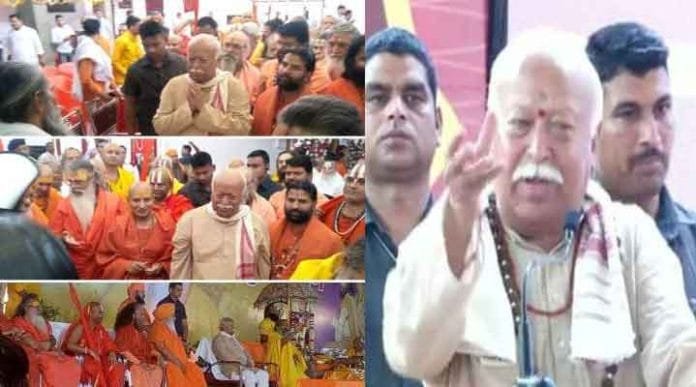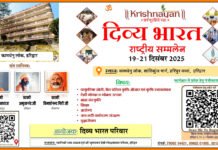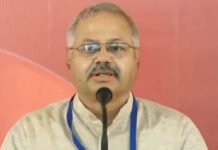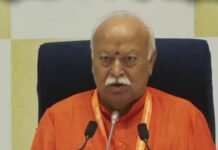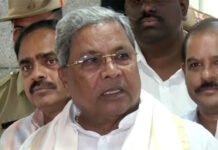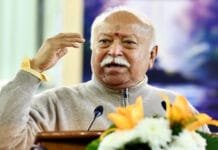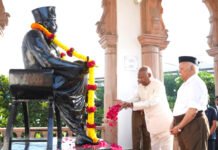INVC NEWS
Kashi : Dive into the International Temples Convention and Expo, where representatives from 400 temples share their experiences, shaping the future of temples as centers of service and unity. Sanghchalak Mohan Bhagwat’s powerful speech highlights the role of temples in national unity, setting forth a vision of temples as beacons of Indian art and devotion.
The grand Mahakumbh of temples took place with a noble objective of uniting temples from all over the country under one unified platform. The International Temples Convention and Expo held at the Rudraksh Convention Center in Varanasi saw participation from representatives of approximately 400 temples worldwide, who came together to share their invaluable experiences.
Uniting Temples: A Vision for National Unity
The inauguration of this momentous program witnessed a powerful address by Sanghchalak Mohan Bhagwat of the Rashtriya Swayamsevak Sangh (RSS). In his speech, he emphasized the need to elevate temples from being just places of worship to centers of profound religious service and repositories of Indian art. According to him, temples play a pivotal role in fostering national unity. By connecting temples from east to west and north to south through a common thread, India can once again become a Vishwaguru, a guiding light for the world.
Temples Serving All Strata of Society
Mohan Bhagwat called for nurturing a new generation of temple custodians who would be willing to dedicate themselves to the service of the nation and its cultural heritage. He stressed the importance of having temples that cater to the diverse needs of society, offering solace to the distressed, shelter to the needy, imparting knowledge, inspiring devotion, and actively engaging in social welfare activities. Temples, traditionally centers of worship, should also evolve into hubs of service, education, and medical assistance.
Drawing inspiration from the Tirupati Balaji temple, which takes care of 57,000 temples located in remote villages, Mohan Bhagwat highlighted the importance of connecting these smaller temples with larger ones. Such integration will not only uplift the temples but also the communities they serve, fostering a sense of unity and common purpose.
The Database of Temples: A Revolutionary Step
The RSS has meticulously compiled a comprehensive database encompassing more than 9000 temples across 57 countries, including India. This ambitious undertaking aims to devise a strategy that will unite small temples with larger, more prominent ones, thereby strengthening the essence of Hindutva not only within the country but also across the globe. The convention witnessed the participation of not only representatives from 10 countries physically present in Varanasi but also an additional 22 countries that joined virtually.
Towards a White Paper: A New Era for Temple Income and Power
The three-day convention, an event of immense importance, has set the stage for a revolutionary paradigm shift in the management and empowerment of temples in India and abroad. With 700 temple managers coming together on one platform, this is a landmark moment in itself. The organizers have outlined their plans and deliberations to issue a white paper that will present their vision and mission in a comprehensive and well-articulated manner.
Prasad Lad, the chairman of the organizing committee, has further underscored the significance of such conventions, proposing that they should be held every three years. He advocates for funds generated by the temples to be utilized for the welfare of the common people, with special focus on temple renovations and providing langar (free food) services to devotees and the underprivileged. The aim is to integrate temples into the fabric of social service, contributing to the betterment of society at large.
Insightful Observations: Expert Opinions
Eminent journalist Vijay Trivedi commends the RSS’s long-standing efforts to unite temples and Hindus. The approach taken by the Sangh chief in connecting temples across the country during the Kashi temple conference resonates deeply. Currently, temples are scattered and often disconnected from each other, leading to varying degrees of prosperity. While temples like Tirupati Balaji and Padmanabha are financially robust, many others, especially those in rural areas, face challenging circumstances.
Vijay Trivedi explains that the underlying intention of the RSS is not solely to unite temples but to foster unity among Hindus as well. The campaign for “one temple, one cremation ground, one well” in every village is part of the larger mission to dissolve caste-based distinctions and promote Hindutva as a unifying force. By ensuring that temples cater to all strata of society, including Dalits, tribals, and OBC communities, the Sangh sends a powerful message of social inclusion and cohesion.
Redefining Temple Independence: Freedom from Government Interference
In recent times, the financial struggles of several temples have led to appeals for governmental support for maintenance and the sustenance of priests. However, temple managers have been increasingly averse to governmental intervention in temple affairs and revenue management. In response, the RSS seeks to liberate temples from government control, encouraging self-sufficiency and strength in their operations. Drawing inspiration from the functioning of Sikh gurudwaras and Christian churches, the Sangh envisions a cohesive network of temples working independently yet united in purpose.
The Noble Purpose of Temple Donations
The Sangh chief emphasizes that temple donations should be utilized for the greater good, considering the selfless and compassionate nature of Hindu mythology. The temples should serve as beacons of service to society, showcasing the true essence of Hinduism to the world. With this vision in mind, the convention aimed to unite a vast number of temple administrators. However, the absence of Shankaracharyas raises questions about the level of agreement among temple managers regarding coming under the unified roof of the Sangh.
In conclusion, the grand Mahakumbh of temples organized by the RSS in Varanasi marks a historic step towards unifying temples and Hindus worldwide. The gathering of temple representatives from diverse corners of the globe and the thoughtful insights shared by experts demonstrate a profound commitment to the upliftment of society through the medium of temples. As the RSS charts a course towards independence from government interference and greater self-reliance for temples, the vision of a united and inclusive Hindu society emerges, promising a brighter future for all. The convention’s objective of uniting temples under one unified umbrella reflects a powerful endeavor to strengthen the essence of Hindutva and foster a sense of unity and purpose in the hearts of Hindus worldwide.

